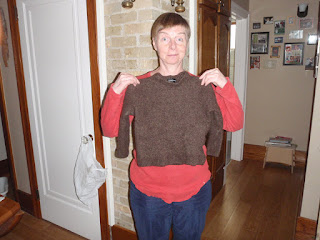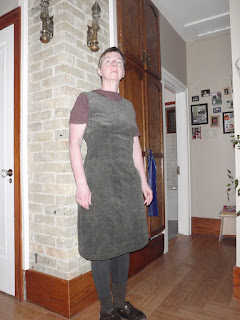Note to Self; See? I didn't have to buy a thing! I can now justify my HUGE stash of stuff. (Cue the celebratory fireworks!)
Briefly: Not happening. Maybe I should give this part up.
In mid-November I had corrective surgery on my foot. I had time to make a couple of cast/walking boot covers to keep my foot warm outside and to keep me the cast/boot from scratching me at night.
The two covers, basically glorified Christmas stockings with a long tie in front to keep them on, were made of blue cotton flannel (for night time) and polar fleece for outside appointments. The night cover proved to be too short for the boot and the velcro strapping still scratched, so I ended up covering the cast/ boot with an old pillow case tied on with a bit of elastic.
 |
| cotton flannel |
I also made a toe cover but that item was not photographed. Basically I drew around my winter boot and made a half-moon cover that fit only over my toes.
 |
| polar fleece |
 |
| unintentional pattern matching |
I was pleased with the pattern matching across the toe and even more tickled by the way it matched on the bottom.
 |
| "treads" |
We were fortunate this year that we didn't have any real snow until early December and since I was non-weight bearing for the first six weeks I didn't have to worry about the durability of the boot.
Near the middle of December I realized I had only about two weeks to get a warmer and more resilient cover ready as I'd start utilizing the 'walking' part of the walking boot just after Christmas.
I opened the bottom of the polar fleece cover and put it on the walking boot, then layered felted wool over the fleece, securing them with the cover straps while I 'quilted' the wool in place. There are five layers of fleece and wool over the toes and three over the rest of my foot.
I then put the whole shebang on a piece of waxed cotton and cut out external cover.
The wool is from two different sweaters but since it isn't on display I didn't fuss about that too much.
The weatherproof cover didn't have a bottom. I wasn't keen on this (major drafts) but I had fears any fabric I used would just become icy and slippery so I planned to use the treads on the walking boot to provide traction. I zigzagged a piece of taut elastic around the inside of the bottom of the boot to hold all the layers together and to hold it in place.
A zipper and snaps keep it closed in the back. Of course, I didn't have a brass zipper or silver snaps. I kind of expected both to appear just after I finished this -you know that's how these things go.
From the side, the little rascal has a rather pugnacious expression.
And from the front it looked rather like a crabby rhinoceros. I was going to embroider a face on the front but figured it was rather senseless to poke all those holes into waxed fabric...
On Friday I decided I wasn't entirely happy with the open bottom. While it kept my foot warm enough it obviously didn't keep the boot clean. It was bad enough hauling around rags to dry my crutches but I wasn't sure if I could dry the sole of the boot properly. I neither wanted to slip nor track up my friends' floors.
This summer The Geek had re-soled some of her sandals and thankfully remembered she still had some of the crepe-sole material left so I started hatching a plan to close the bottom.
I drew around the base of the walking boot (left) and then around the cover.
The Geek didn't think the crepe would stick to the waxed cotton so I cut out a piece of both waxed cotton and regular cotton,
stitched them, wrong-side together, and then flipped the right side out and stitched again.
I traced around the boot template so I'd know where to apply the Barge cement (bluish tube).
Then used the same template to cut out the crepe soling.
The glue was applied to the crepe and the fabric and allowed to cure for about 10 minutes.
The Barge cement is stinky stuff so we put it on the stove top under the exhaust fan to air out.
The crepe was then positioned on the fabric and covered with a piece of paper so any excess glue would wind up on the paper and not on the bottle.
The cement needs some firm pressure to adhere properly and extra rolling was done around he very edges of the crepe to keep it from peeling up later. The bottle was excellent for this task.
I flipped the boot inside out and positioned the sole with clothes pins.
Then zigzagged it in place.
I made the sole a little big so it would extend past the waxed cotton and keep it from rubbing on the ground. I noticed after wearing them outside that the crepe sole should have been a bit farther back but that would have been hard to figure out beforehand.
A size comparison; the boot cover, my regular winter boot and my hiking boot.
 |
| Bicycle pump on the far left. |
Today, at -23, both feet were equally warm so I can call this a win. I'll have to see what happens when it gets colder.
And here is my PSA: The Geek added a 'platform' to my indoor shoes so my hips are the same height. Walking boots tend to do a number on your back, hips, and knees because of the difference in height from one leg to the other. Here she used the bottom from an old pair of thongs (or flip-flops if that's what you call them where you are), drilled holes for some loops and used lock-lacing to keep them in place. If I'd had a pair of shoes with thicker soles they would have worked just as well but wouldn't be such a conversation starter.



















































